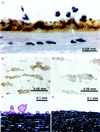Blood-borne tissue factor: another view of thrombosis
- PMID: 10051638
- PMCID: PMC26780
- DOI: 10.1073/pnas.96.5.2311
Blood-borne tissue factor: another view of thrombosis
Abstract
Arterial thrombosis is considered to arise from the interaction of tissue factor (TF) in the vascular wall with platelets and coagulation factors in circulating blood. According to this paradigm, coagulation is initiated after a vessel is damaged and blood is exposed to vessel-wall TF. We have examined thrombus formation on pig arterial media (which contains no stainable TF) and on collagen-coated glass slides (which are devoid of TF) exposed to flowing native human blood. In both systems the thrombi that formed during a 5-min perfusion stained intensely for TF, much of which was not associated with cells. Antibodies against TF caused approximately 70% reduction in the amount of thrombus formed on the pig arterial media and also reduced thrombi on the collagen-coated glass slides. TF deposited on the slides was active, as there was abundant fibrin in the thrombi. Factor VIIai, a potent inhibitor of TF, essentially abolished fibrin production and markedly reduced the mass of the thrombi. Immunoelectron microscopy revealed TF-positive membrane vesicles that we frequently observed in large clusters near the surface of platelets. TF, measured by factor Xa formation, was extracted from whole blood and plasma of healthy subjects. By using immunostaining, TF-containing neutrophils and monocytes were identified in peripheral blood; our data raise the possibility that leukocytes are the main source of blood TF. We suggest that blood-borne TF is inherently thrombogenic and may be involved in thrombus propagation at the site of vascular injury.
Figures



References
-
- Fuster, V., Fallon, J. T. & Nemerson, Y. (1996) Lancet348, Suppl. 1, s7–s10. - PubMed
-
- Zeldis S M, Nemerson Y, Pitlick F A, Lentz T L. Science. 1972;175:766–768. - PubMed
-
- Badimon J J, Weng D, Chesebro J H, Fuster V, Badimon L. Thromb Haemostasis. 1994;71:511–516. - PubMed
-
- Kirchhofer D, Riederer M A, Baumgartner H R. Blood. 1997;89:1270–1278. - PubMed
-
- Fuster V, Fallon J T, Badimon J J, Nemerson Y. Thromb Haemostasis. 1997;78:247–255. - PubMed
Publication types
MeSH terms
Substances
Grants and funding
LinkOut - more resources
Full Text Sources
Other Literature Sources
Medical
Miscellaneous

